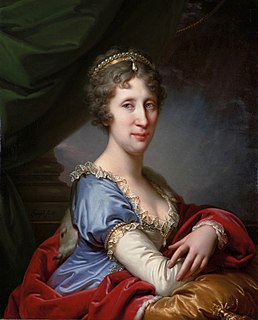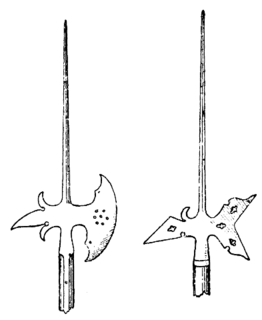
A grenadier was originally a specialized soldier, first established as a distinct role in the mid-to-late 17th century, for the throwing of grenades and sometimes assault operations. At that time grenadiers were chosen from the strongest and largest soldiers. By the 18th century, dedicated grenade throwing of this sort was no longer relevant, but grenadiers were still chosen for being the most physically powerful soldiers and would lead assaults in the field of battle. Grenadiers would also often lead the storming of fortification breaches in siege warfare, although this role was more usually fulfilled by all-arm units of volunteers called forlorn hopes, and might also be fulfilled by sappers or pioneers.
The Grande Armée was the army commanded by Napoleon I during the Napoleonic Wars. From 1805 to 1809, the Grande Armée scored a series of historic victories that gave the French Empire an unprecedented grip on power over the European continent. Widely acknowledged to be one of the greatest fighting forces ever assembled, it suffered terrible losses during the French invasion of Russia in 1812 and never recovered its tactical superiority after that campaign.

The M1903 Springfield, formally the United States Rifle, Caliber .30-06, Model 1903, is an American five-round magazine fed, bolt-action service repeating rifle, used primarily during the first half of the 20th century.
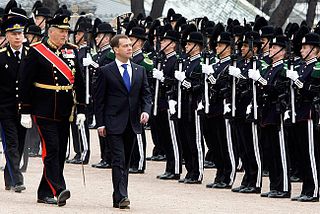
In some militaries, foot guards are senior infantry regiments. Foot guards are commonly responsible for guarding royal families, or other state leaders, and they also often perform ceremonial duties accordingly.

A military parade is a formation of soldiers whose movement is restricted by close-order manoeuvering known as drilling or marching. The military parade is now almost entirely ceremonial, though soldiers from time immemorial up until the late 19th century fought in formation. Massed parades may also hold a role for propaganda purposes, being used to exhibit the apparent military strength of one's nation.

The Royal Regiment of Canada is a Primary Reserve infantry regiment of the Canadian Army based in Toronto, Ontario, part of 4th Canadian Division's 32 Canadian Brigade Group. Today, the regiment has a total of three companies:

Fusilier is a name given to various kinds of soldiers; its meaning depends on the historical context. While fusilier is derived from the 17th-century French word fusil – meaning a type of flintlock musket – the term has been used in contrasting ways in different countries and at different times, including soldiers guarding artillery, various elite units, ordinary line infantry and other uses.

Beating Retreat is a military ceremony dating to 16th century England and was first used to recall nearby patrolling units to their castle.

The Gewehr 98 is a German bolt action rifle made by Mauser firing cartridges from a 5-round internal clip-loaded magazine. It was the German service rifle from 1898 to 1935, when it was replaced by the Karabiner 98k, a shorter weapon using the same basic design. The Gewehr 98 action, using a stripper clip loaded with the 7.92×57mm Mauser cartridge, successfully combined and improved several bolt action engineering concepts which were soon adopted by many other countries including the UK, Japan, and the US. The Gewehr 98 replaced the earlier Gewehr 1888 rifle as the main German service rifle and first saw combat in the Chinese Boxer Rebellion and was the main German infantry service rifle of World War I. The Gewehr 98 saw further military use by the Ottoman Empire and Nationalist Spain.

Full dress uniform is the most formal type of military uniform, reserved for parades, ceremonies, official receptions, and other special occasions of the most formal level, including private ones such as marriages and funerals. Full dress uniforms often goes with order insignias and full size medals. In Western dress codes, full dress uniform is a permitted supplementary alternative corresponding to the civilian white tie for evening wear or morning dress for day wear - sometimes collectively called full dress - although military uniforms are the same for day and evening wear.

The uniforms of the British Army currently exist in twelve categories ranging from ceremonial uniforms to combat dress. Uniforms in the British Army are specific to the regiment to which a soldier belongs. Full dress presents the most differentiation between units, and there are fewer regimental distinctions between ceremonial dress, service dress, barrack dress and combat dress, though a level of regimental distinction runs throughout.
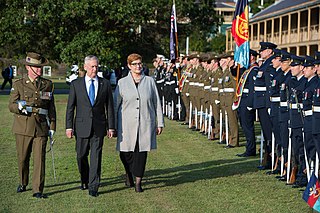
A guard of honour (en-GB), guard of honor (en-US), also honour guard (en-GB), honor guard (en-US), also ceremonial guard, is a guard, usually military in nature, appointed to receive or guard a head of state or other dignitary, the fallen in war, or to attend at state ceremonials, especially funerals. In military weddings, especially those of commissioned officers, a guard, composed usually of service members of the same branch, form the Saber arch. In principle any military unit could act as a guard of honour. However, in some countries certain units are specially designated for guard of honour duty.

The Imperial and Royal or Imperial Austrian Army was strictly speaking, the armed force of the Holy Roman Empire under its last monarch, the Habsburg Emperor Francis II, although in reality, it was nearly all composed of the Habsburg army. When the Holy Roman Empire was dissolved in 1806, it assumed its title of the Army of the Austrian Empire under the same monarch, now known as Emperor Francis I of Austria.

The Berthier rifles and carbines were a family of bolt-action small arms in 8mm Lebel, used in the French Army from the 1890s to the beginning of World War II (1940).

The Universalmuseum Joanneum is a multidisciplinary museum with buildings in several locations in the province of Styria, Austria. It has galleries and collections in many subject areas including archaeology, geology, paleontology, mineralogy, botany, zoology, history, art and folk culture. It is the oldest museum in Austria as well as the largest universal museum in central Europe with over 4.5 million objects in 13 departments and 12 locations in the Styrian cities of Graz, Stainz, Trautenfels, and Wagna. To reflect this status and its growth over the last two centuries, as well as to present a more recognizable image internationally, the Landesmuseum Joanneum was officially renamed to Universalmuseum Joanneum on 10 September 2009.

The Bosnian-Herzegovinian Infantry, commonly called the Bosniaken, were a branch of the Austro-Hungarian Army. Recruited from outside the Austrian and Hungarian regions of the Dual-Monarchy, with a significant proportion of Muslim personnel (31.04%), these regiments enjoyed a special status. They had their own distinctive uniforms and were given their own numbering sequence within the Common Army (KuK).

Guido Dessauer was a German physicist, specialized in paper engineering, a business executive, writer, art collector, patron of arts, and academic. Born into a family of paper industrialists, he worked as an aerospace engineer during World War II and was an executive of the family's coloured paper factory in Aschaffenburg from 1945. He was an honorary citizen of Austria for saving 300 jobs in Styria in the 1960s. He earned a Ph.D. from the Graz University of Technology in his late 50s and became an honorary professor there. Interested in art, he collected bozzetti for 50 years and initiated the career of Horst Janssen as a lithographer.

The Imperial-Royal Landwehr, also called the Austrian Landwehr, was the territorial army of the Cisleithanian or Austrian half of the Austro-Hungarian Empire from 1869 to 1918. Its counterpart was the Royal Hungarian Landwehr. The two Landwehrs, together with the Common Army and the Imperial and Royal Navy, made up the armed power of Austria-Hungary.
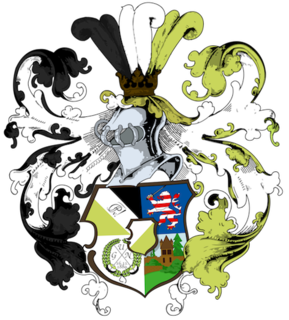
The Corps Franconia Darmstadt is a fraternity founded on November 16, 1889 in Darmstadt. It is one of the 59 German Student Corps within the Weinheimer Senioren-Convent (WSC), the second oldest federation of classical European fraternal corporations, with roots dating back to the 15th century and fraternities founded in several European countries.







